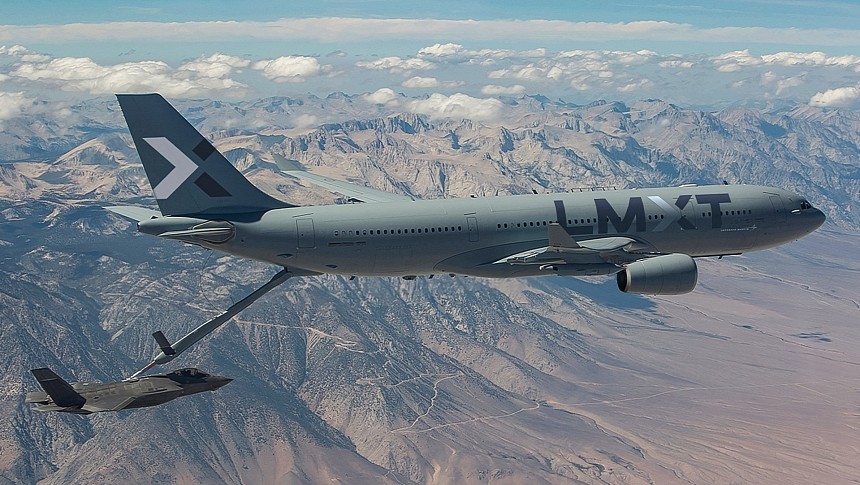As it seeks to completely modernize its military, the U.S. is also looking at the pieces of hardware that keep its main weapons platforms up and running. And that includes aerial tankers, the flying gas stations that have had a major role in establishing the U.S. as the dominant air power in the world.
At the time of writing the U.S. holds the largest tanker fleet in the world. Around 700 airplanes get filled with fuel, take to the sky, and distribute the substance to the military aircraft in need. As it stands, that's too large of a number even for America, so plans are to cut that down to about 450 planes.
Part of that streamlined fleet will be something called LMXT. Made by Lockheed Martin, it's a flying tanker based on the Airbus A330, and derived from the Multi Role Tanker Transport (MRTT) already in use with 14 countries around the world.
Being meant for use at the hands of the American military, the plane in LMXT configuration will of course be different (and more advanced) than the MRTT. In the European spec, the MRTT is powered by a choice of three engine families, the Rolls-Royce Trent, General Electric CF-6, and Pratt & Whitney.
This week Lockheed Martin announced one of the three engine makers will be responsible for the hardware powering the LMXT as well. More to the point, General Electric was chosen as the engine supplier, and the CF6-80E1 powerplant variant is the one that'll make its way under the wings of the tanker.
The CF6 is one of the most widespread aircraft engines in the world. In production since the early 1970s, it has been deployed on military aircraft before, including the C-5M Super Galaxy, but also on civilian planes. In fact, the CF6 powers no less than 70 percent of the wide-body aircraft currently in use around the world (including the A330) – in all, the tech has been produced in no less than 8,500 units so far.
It's not yet clear what the exact specifications of the powerplant in the LMXT configuration will be. As is, the high-pass turbofan delivers between 67,500 and 72,000 pounds of thrust.
Production of the new American tanker is scheduled to begin by the end of the decade. Airbus will make it first as an airliner in Mobile, Alabama, and it will then be shipped to Marietta, Georgia, where Lockheed Martin will convert it into the LMXT.
One of the ways it will do that is by fitting it with the world's first fully automatic boom. That's the air-to-air refueling (A3R) system that's at the core of aerial tankers. Unlike traditional systems, which require constant adjustments from an operator, this one keeps the alignment between its tip and the receiver receptacle on its own, "with an accuracy of a couple of centimeters."
Knowing what engines the airplane will use is a major step forward in getting closer to the full picture of the LMXT. More details are expected though as the aircraft moves closer to production.
Part of that streamlined fleet will be something called LMXT. Made by Lockheed Martin, it's a flying tanker based on the Airbus A330, and derived from the Multi Role Tanker Transport (MRTT) already in use with 14 countries around the world.
Being meant for use at the hands of the American military, the plane in LMXT configuration will of course be different (and more advanced) than the MRTT. In the European spec, the MRTT is powered by a choice of three engine families, the Rolls-Royce Trent, General Electric CF-6, and Pratt & Whitney.
This week Lockheed Martin announced one of the three engine makers will be responsible for the hardware powering the LMXT as well. More to the point, General Electric was chosen as the engine supplier, and the CF6-80E1 powerplant variant is the one that'll make its way under the wings of the tanker.
The CF6 is one of the most widespread aircraft engines in the world. In production since the early 1970s, it has been deployed on military aircraft before, including the C-5M Super Galaxy, but also on civilian planes. In fact, the CF6 powers no less than 70 percent of the wide-body aircraft currently in use around the world (including the A330) – in all, the tech has been produced in no less than 8,500 units so far.
It's not yet clear what the exact specifications of the powerplant in the LMXT configuration will be. As is, the high-pass turbofan delivers between 67,500 and 72,000 pounds of thrust.
Production of the new American tanker is scheduled to begin by the end of the decade. Airbus will make it first as an airliner in Mobile, Alabama, and it will then be shipped to Marietta, Georgia, where Lockheed Martin will convert it into the LMXT.
One of the ways it will do that is by fitting it with the world's first fully automatic boom. That's the air-to-air refueling (A3R) system that's at the core of aerial tankers. Unlike traditional systems, which require constant adjustments from an operator, this one keeps the alignment between its tip and the receiver receptacle on its own, "with an accuracy of a couple of centimeters."
Knowing what engines the airplane will use is a major step forward in getting closer to the full picture of the LMXT. More details are expected though as the aircraft moves closer to production.

















